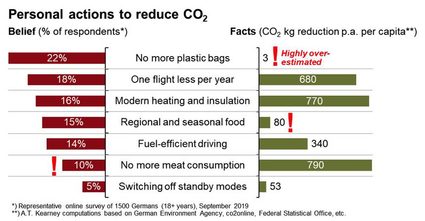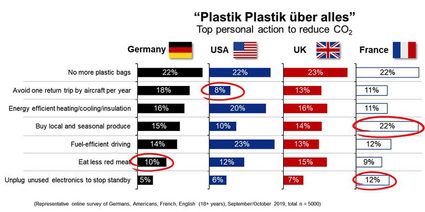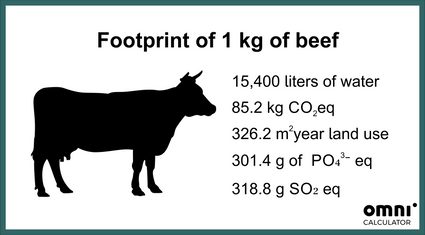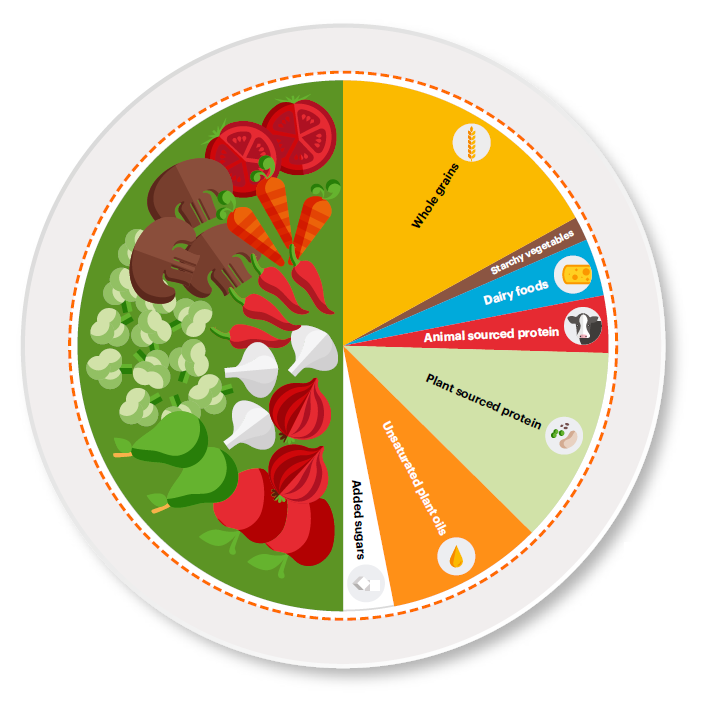How Much Meat Do People Eateachyear How Many Resources Go Into a Pound of Beef
Meat production has an enormous environmental touch on on our planet. Did you know that animal agronomics is the second largest source of man-caused greenhouse gas emissions? While carbon dioxide product and water consumption come to our minds first, in that location are other things that we don't actually recollect about - the amount of land needed, or the pollution of the air, h2o and land. At that place is besides the feed the animals need, which could be used more productively.
Have you always wondered what resources are needed to produce your steak or the meat for your BBQ? How many miles should yous walk instead of drive to offset your carnivorous habits? Our meat footprint calculator is here to answer those questions, and to assist you learn about the true cost of meat🍗.
Don't worry, we don't want to convince y'all to become vegan, simply to reduce the amount of meat in your nutrition. Just accept a look at the numbers, read about the environmental toll, and accept a call back: "Is reducing my meat consumption - fifty-fifty by just i steak or a few chicken nuggets per calendar week - such a large cede?" Maybe a flexitarian or planetary health nutrition is worth trying? Call back that reducing this is a way to assist non only the climate and environment, just also your health!
Meat consumption on a big scale
Meat consumption has recently soared, as more countries begin to develop and global society is getting richer. In the terminal 50 years, the corporeality of meat eaten globally quadrupled, exceeding ! Unfortunately, meat is very inefficient food if you lot take into account the resource needed for product and the amount of protein obtained. Needless to say, meat product creates pressure on crop and h2o resource, not to mention the huge demand for land leading to biodiversity loss. Do yous know that sixty% of the globe's mammals are livestock, and ?

Creature agriculture is the 2d biggest source of anthropomorphic greenhouse gas emissions, existence responsible for about worldwide (~64% comes from the main contributor to global warming: the energy and transportation sector). The most significant greenhouse gas associated with meat product is marsh gas. Meat production is the single most important source of this greenhouse gas - livestock produces around .
Besides, vast amounts of other greenhouse gases are emitted during meat production, mainly carbon dioxide, CO₂, and nitrous oxide, North₂O. Even though we hear a lot most CO₂, nitrous oxide has much greater potential for global warming than carbon dioxide (nigh ), as well as depleting the ozone layer.
That was some facts and numbers. Pretty overwhelming. But what can we do most that? What personal activeness can nosotros undertake to reduce our carbon footprint, at a personal level calibration? According to , the three things which can help you reduce your carbon footprint are (in order of effectiveness):
- 🍗 No more meat consumption (790 CO₂ kg/year)
- 🌡️ Modern heating and insulation (770 CO₂ kg/year)
- ✈️ 1 flight less per year (680 CO₂ kg/year)
Interestingly, banning plastic bags has the smallest impact on carbon footprint reduction out of the seven actions mentioned in a survey, at only a 3 kg reduction (don't forget about all of the plastic in the ocean, though). The authors as well checked what people think reduces their footprint the most. And here comes the most mind-blowing decision - people usually believe that giving up on plastic numberless is the most of import matter!

The results are even more interesting when we look at the nationality of the responders:

Have you noticed that
The writer of the study is convinced that "the majority of the result is driven by lack of knowledge". We hope so also. We promise that it's non our laziness and uncomplicated want for convenience. So now, afterward reading this article, you shouldn't accept whatsoever excuses.
Many researchers are alarm that water shortages may atomic number 82 to the next global conflict and dandy migration of people. At that place are estimates that over ⅔ of freshwater withdrawals go to irrigation for agriculture, and . Meat production is a great contributor, making up a pregnant amount of h2o from these percentages.
Beefiness production needs the most h2o - it requires over four 000 gallons (xv,000 liters) of h2o to produce 2.ii lbs (i kg) of meat, making information technology the most water-intensive protein! Lamb is a flake less greedy (over 2700 gallons/ten,400 liters), and poultry production takes 1100 gal (4300 l) per kilo of meat. That's rather a lot, especially when compared to what we potable on a daily basis.
In today'southward globe, (all of World'south state, excluding deserts and water ice-covered regions). From that, approximately fourscore% is associated with brute agriculture, mostly meat production. To give you lot some numbers, on boilerplate, beef production requires ~22 times more land than pea production . If the cattle are instead a dairy herd, then "only" half dozen times more farmland is used for the same corporeality of protein from peas.
Differences in dietary habits are immense - if every person in the world had the , 95% of global habitable area would be needed for agriculture. Even more terrifying results appear if the whole earth chooses the United states of america's average diet - 138% of the global habitable area would be needed! Unfortunately, we tin can't do it - we don't have a spare planet.

On the other hand, if everybody changed to a vegan diet, land use could exist reduced by more 75%! . With the human population growing rapidly, nosotros'll need more and more land for living, but also for nutrient production...
Do we yet need to convince you that the change in our lifestyle and nutrition is inevitable?
Meat production not just produces greenhouse gases, it as well produces a lot of different byproducts, but we volition only mention ammonia and particulate matter. They can be unsafe to our health and may lead to respiratory problems, besides equally leading to the deterioration of water, air, and state. So how does meat production atomic number 82 to pollution?
- Water pollution
Eutrophication is the over-enrichment of nutrients in a system, by and large by nitrogen or phosphorus (phosphate ions). Information technology causes algae blooms, which tin be toxic to animals and people, but as well very harmful to the ecosystem (dead zones, fish deaths, subtract in biodiversity, new species invasion). Have you ever heard that nutrient production is responsible for ~78% of global eutrophication? That's an unbelievably loftier percentage! In the livestock and agronomical sector, the nutrients come from beast manure, fertilisers (equally approximately one-third of the globe'southward grain is fed to animals), leftover feed, and crop residues. Meat production contributes to a significant part of agronomical eutrophication - for instance, red meat product has an environmental impact 10 to 100 times larger than a plant source food.
- Air and land pollution
Ammonia coming from manure is the dominant source of acidifying emissions during livestock product. Overall, the livestock industry is responsible for , contributing significantly to acid rains and ecosystem acidification.
Beef - the biggest polluter
If yous're a meat-eater, who can't imagine life without steak or craven, you don't take to go the whole pig. Just eat more greens, or at least care more than nearly what type of meat y'all're eating - try to avoid highly-processed meat 🍔 and red meat 🥩 when possible, and remember that the beef meat is the greatest Resource Reaper.

The United states is the biggest beef producer worldwide, and also one of the acme countries when it comes to beefiness consumption per person. Let'due south attempt to change it!
The studies behind calculator - ecology part
The environmental office of our meat footprint computer is based mostly on a . The authors checked over i,500 studies on life cycle assessments around the world, finally choosing over 1/3 of them that meet the imposed criteria and methodology. They consolidated data from over 38,000 farms in about 120 countries. On that basis, different ecology footprints were estimated, including, e.m., greenhouse gases, acidification, eutrophying emissions, and land apply. As expected, the authors found out that the ecological footprint is highly variable, as it depends on the whole food production chain: methods, location, transport process, retail and consumer deportment, and many many more factors.
To brand this tool, nosotros've chosen 5 popular meat types: craven/poultry, beef, pork, lamb, and fish. The Science study provided information for the protein content and iv environmental factors: carbon dioxide equivalent, land use, h2o pollution, and air pollution. Nosotros and so took the mean values from each of the footprints and recalculated them into values per weight of the meat. And then, to gauge the h2o footprint, we used data from , while to appraise the required animal feed, we used . In nigh cases, fish were not included in the studies and so we took the information from other sources, which you lot'll find in our section.
1 of the pregnant results of the Science written report is the fact that even the everyman-impact brute production exceed the the impact of the average vegetable substitute, usually by many times. This should atomic number 82 to the decision that even a small diet change is really beneficial for the environs. Merely let's have a look a bit more selfishly - what are the health benefits of reducing meat consumption?
Health benefits of reducing meat intake
Not only the environs will thanks for reducing your meat intake – you tin also thank yourself. Over the last years, meat has been moving upwards in the food pyramid, which means information technology becomes more of an occasional nutrient than a footing of daily nutrition. There is a broad range of reasons behind that.
We see that every month a new food product is demonised, that information technology is mortiferous, causes cancer, and should be banned. But facts are facts – high meat intake is linked to a greater risk of and . It applies especially to red meat – pork, beef, lamb, especially in their candy forms (candy meats include hot dogs, ham, canned meat, pâtés etc.).
All the meaning world health associations - WHO, , , and all concur that meat consumption should be reduced in order to lead a healthier lifestyle. There are no strict prophylactic limits here, but general skilful practice is to eat no more than one portion (70-100 g or 2.5-3.five oz, uncooked weight) per twenty-four hours or 2 portions (about 200 g or 7 oz) 3-4 times a week. The lower weight of one portion, lxx thou, is recommended if you would similar to minimize the risk associated with meat-eating. As for candy meat - you should keep it to an absolute minimum or just zip.
New diet trends: planetary health diet and flexitarian diet
If you don't feel like becoming a vegan today, we've got some good news for you - it'southward not necessary! Currently, most recommendations focus on implementing small changes that, when multiplied, add up to a big difference - for individual health and for the planet! The diet that meets both conditions is called a planetary health nutrition.
The planetary health diet was introduced in 2019, and supported past the report by the Swallow-Lancet Commission from The Lancet - the world's leading scientific medical periodical. Thirty-7 experts on health, nutrition, and environmental sustainability agree that nutrient is the single strongest lever to act on both planetary and individual human health.

source:
Half of the planetary health plate consists of vegetables, fruits, and nuts. The other half consists of whole grains, plant proteins similar legumes, plant oils, and just then beast-derived foods, similar dairy and meat. Carbohydrate is at the very bottom.
Various diets can meet the criteria of the planetary health nutrition - vegetarianism, pesco-vegetarianism, veganism. An like shooting fish in a barrel to adopt alternative seems to be the flexitarian diet. This type of diet assumes an increased intake of fruits and vegetables just allows an occasional meat meal. The flexitarian diet brings a lot of hope for improving man and planetary health - every increment in vegetable intake is valuable, and the possibility of eating meat from fourth dimension to time is remarkably soothing for many of united states of america.
In the wellness department of the calculator, you can see how irresolute your meat intake volition affect certain health-indicators. Both saturated fatty acids and sodium can **seriously contribute to cardio-vascular diseases - stroke, myocardial infarction, and hypertension development. Saturated fats are particularly egregious, since the recommendations say that you should preferably not eat them at all. Nonetheless, many people effectually the earth swallow them daily in the form of meat, processed foods, and sweets.
At that place are some articulate advantages of eating more vegetables, fruit, and whole grains (vitamins, microelements, fiber). But, if you driblet your meat intake, you'll probably reach out for legumes, pulses, and nuts to make certain y'all eat enough protein. And this is beneficial for your health!
- Legumes, especially soybeans, are known to - probably because they help you to reach a healthy body weight.
- They help with favorable changes in your .
- College intake of pulses lowers the risk of (like stroke or myocardial infarction) and .
- Eating only half of a can (100g) of legumes 4x a calendar week results in .
Doesn't it all sound convincing?
Take home message
Co-ordinate to the newest research, the - that means the products associated with health improvement (such as vegetables, fruits, whole grains) usually accept a low touch on the environment. It sounds similar a win-win situation!
As a take-abode message, let the states paraphrase the slogan from :
Nosotros don't need a handful of people performing meat reduction perfectly, past changing to a vegan or vegetarian diet. We need millions of people doing it imperfectly, reducing meat consumption every bit much as possible.
References, data sources:
- Carbon footprint, land use, water pollution, air pollution, proteins/kg:
- Water footprint:
- Fish water footprint:
- Animal Feed:
- Fish feed: (judge)
- CO2 equivalents- phones charged, gasoline consumed, distance driven by car:
If in that location is no reference for a piece of ecological data, the Scientific discipline article is virtually likely the source.
Hanna Pamuła , PhD candidate and Aleksandra Zając , Doc
My actual meat consumption 🥩🥓🍗
Hitting 'Advanced mode' button to enter meat amount in weight units
Source: https://www.omnicalculator.com/ecology/meat-footprint
0 Response to "How Much Meat Do People Eateachyear How Many Resources Go Into a Pound of Beef"
Post a Comment